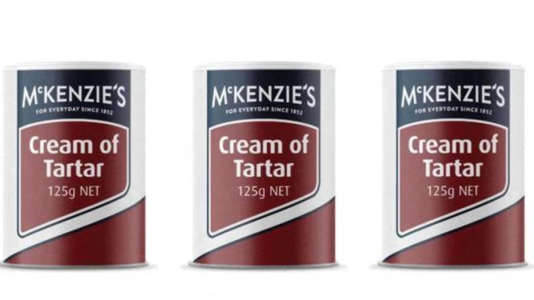Discover the secret ingredient for your baking success and how to use it
As we age, we tend to have more time on our hands, and for many of us, that means rediscovering our love for cooking and baking. For our resident bakers, one pantry staple that often baffles us is the mysterious cream of tartar. We know it’s important for many recipes, but what is it actually, and how do we use it effectively?

While organising your baking drawer or pantry, you may have come across that trusty container of cream of tartar, and you might just be wondering what it's made of and how it works its magic. Fret not! We've done the research to help you understand – and better utilise – this remarkable ingredient.
As it turns out, cream of tartar speeds up bubble formation in liquids. It helps create stable yet aerated textures and keeps egg whites and sugar from crystallising during mixing. When making meringues or pavlovas, cream of tartar stops the egg proteins from sticking together, thereby stabilising air pockets. Thanks to this unique ingredient, you can achieve the fluffy, sky-high, melt-in-your-mouth meringues that everyone adores.
Cream of tartar is high in potassium, which is an essential mineral that can promote heart health and help to reduce high blood pressure. This is because it helps to relax and open the blood vessels, which can help decrease the amount of stress placed on the cardiovascular system.
Overall, cream of tartar can provide several health benefits to individuals and may even help to promote healthy eating habits. If you’re looking to incorporate this pantry staple into your diet, be sure to use organic cream of tartar for the best results.
 Armed with newfound knowledge, you're now ready to tackle your next baking adventure with confidence, whether you're revisiting classic recipes or exploring new creations. If you have any classic recipes involving cream of tartar, please share them down below! Happy baking!
Armed with newfound knowledge, you're now ready to tackle your next baking adventure with confidence, whether you're revisiting classic recipes or exploring new creations. If you have any classic recipes involving cream of tartar, please share them down below! Happy baking!

Unravelling the enigma of cream of tartar
While organising your baking drawer or pantry, you may have come across that trusty container of cream of tartar, and you might just be wondering what it's made of and how it works its magic. Fret not! We've done the research to help you understand – and better utilise – this remarkable ingredient.
Unlocking the secret: What is cream of tartar made from?
Our favourite evening beverage has a hand in the creation of cream of tartar. The dry, powdered, acidic sediment that's left behind during the fermentation process is what gives us this extraordinary baking staple. And at the core of it all are grapes, as they are rich in tartaric acid – the primary ingredient in cream of tartar.The indispensable purpose of cream of tartar
You've probably encountered cream of tartar while making some of your favourite desserts, like pavlovas, meringues, cakes, or cookies. But how does it contribute to our delicious creations?As it turns out, cream of tartar speeds up bubble formation in liquids. It helps create stable yet aerated textures and keeps egg whites and sugar from crystallising during mixing. When making meringues or pavlovas, cream of tartar stops the egg proteins from sticking together, thereby stabilising air pockets. Thanks to this unique ingredient, you can achieve the fluffy, sky-high, melt-in-your-mouth meringues that everyone adores.
In search of substitutes for cream of tartar?
No worries if you can't find any cream of tartar in your pantry. You can substitute it with something as simple as lemon juice, which shares its acidic properties. Typically, a teaspoon of lemon juice can replace half a teaspoon of cream of tartar. Just be mindful that doing so may slightly alter the final taste of your baked goods.Don't confuse cream of tartar with bicarb soda
Their similar appearances and packaging can be deceptive, but cream of tartar and bicarb soda are entirely different ingredients. Bicarb soda is alkaline and typically used in recipes that call for moisture and an acidic component, like lemon juice, chocolate, buttermilk or honey, to make batters rise.Health Benefits of Cream of Tartar
Not only does cream of tartar add a unique flavour and texture to baked goods, but it has also been associated with several health benefits. These benefits can be attributed to its natural acidic properties, its high levels of potassium and its ability to act as an antioxidant.Heart Health
Cream of tartar is high in potassium, which is an essential mineral that can promote heart health and help to reduce high blood pressure. This is because it helps to relax and open the blood vessels, which can help decrease the amount of stress placed on the cardiovascular system.
Digestive Health
Cream of tartar can help improve your digestive health by helping to improve the food intake process and promoting better nutrient absorption. The acidity of the cream of tartar can help to break down proteins, making them easier for your body to digest.Bone Health
Cream of tartar is high in calcium, iron and magnesium, which are all essential minerals for healthy bones. The calcium helps to form and maintain the bones, while iron helps to keep them strong. Magnesium helps the body absorb calcium and helps to form new bone tissue over time, making it an essential mineral for long-term bone health.Immune Health
Cream of tartar also contains several antioxidants, which can help to fight free radicals and reduce the inflammation that can occur as a result of an unhealthy lifestyle. By reducing this inflammation, the body can be better equipped to fight illnesses and keep its overall health in check.Overall, cream of tartar can provide several health benefits to individuals and may even help to promote healthy eating habits. If you’re looking to incorporate this pantry staple into your diet, be sure to use organic cream of tartar for the best results.
Key Takeaways
- Cream of tartar is a dry, powder-like, acidic sediment that is a by-product of wine-making, derived from grapes.
- The primary purpose of cream of tartar is to speed up the formation of bubbles in a liquid, creating a stable yet aerated consistency and preventing crystallisation in the mixing process.
- A suitable substitute for cream of tartar can be lemon juice, with one teaspoon of lemon juice equivalent to half a teaspoon of cream of tartar.
- Cream of tartar and bicarb soda are different ingredients, although they share similarities in colour, consistency, and packaging. Bicarb soda is alkaline and used in recipes that mix moisture and an acidic ingredient to make batter rise.







